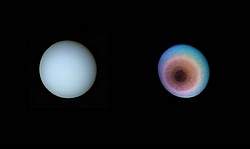
|
Title: Uranus
Caption: Two images of Uranus one in natural color, the other in false color. The natural color image, on the left, is how Uranus would appear to the human eyes. The false color image has been processed so as to reveal changes, and features, that are not normally apparent. The blue-green appearance of the planet is due to the presence of methane in the atmosphere, which absorbs red light. The banding structure seen in the false color image is real, although the differences are exaggerated. The dark polar spot could be due to a polar haze created by ultraviolet light reacting with the methane in the atmosphere.
Copyright:(c) Public Domain
Credit: NASA/JPL
|

